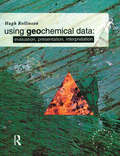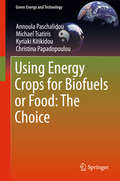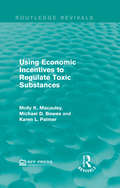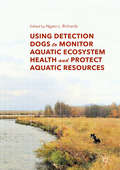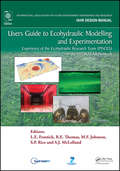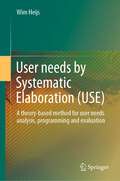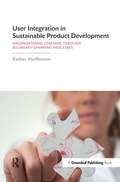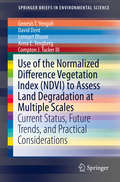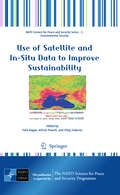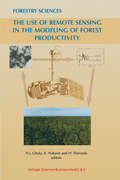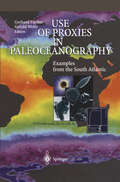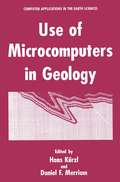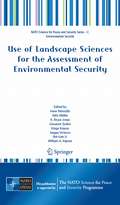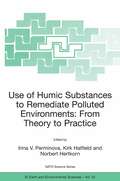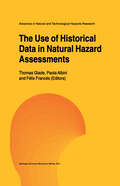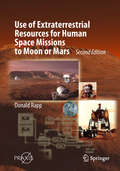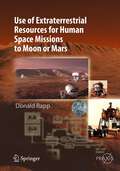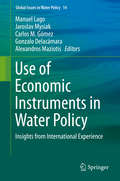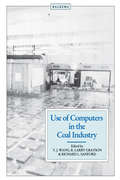- Table View
- List View
Using Geochemical Data: Evaluation, Presentation, Interpretation
by Hugh R. RollinsonUsing Geochemical Data brings together in one volume a wide range of ideas and methods currently used in geochemistry, providing a foundation of knowledge from which the reader can interpret, evaluate and present geochemical data.
Using Geochemical Data: Evaluation, Presentation, Interpretation
by Hugh R. RollinsonUsing Geochemical Data brings together in one volume a wide range of ideas and methods currently used in geochemistry, providing a foundation of knowledge from which the reader can interpret, evaluate and present geochemical data.
Using Energy Wisely: Using Energy Wisely (library Ebook (Environment Detective Investigates #6)
by Jen GreenWhat is energy?Why do we need energy?What is being done to save energy?The Environment Detective Investigates helps you to answer these questions and many more about energy. Find out about the different kinds of energy, what global warming is and what is being done to use energy wisely
Using Energy Crops for Biofuels or Food: The Choice (Green Energy and Technology)
by Annoula Paschalidou Michael Tsatiris Kyriaki Kitikidou Christina PapadopoulouThis book performs a SWOT (strengths, weaknesses, opportunities and threats) analysis to examine the current food crisis and how it relates to the use of crops for energy. It analyses how energy crops may help solve humankind’s environmental changes and summarises the economic and practical changes of cultivating and utilising energy crops. Two of humanity’s greatest challenges are the need for more food production as well as growing demands for energy. Biofuel cultivation has been identified as a solution to growing energy use, and biomass power plants offer a rare renewable energy source that requires only basic technology.In this context, a dilemma arises concerning whether energy crops should be used for energy or to help remedy the food crisis. SWOT analysis allows us to organise and weigh different pros and cons against each other in terms of economics, job creation, environmental impacts, the climate change agenda, and European Union (EU) directives that promote biofuels over fossil fuels. By pursuing this approach, the book helps researchers and decision-makers cut through the many competing arguments in connection with this complex subject.
Using Economic Incentives to Regulate Toxic Substances (Routledge Revivals)
by Molly K. Macauley Michael D. Bowes Karen L. PalmerUsing case studies, the authors evaluate the potential attractiveness of incentive-based policies for the regulation of four specific toxic substances: chlorinated solvents, formaldehyde, cadmium, and brominated flame retardants. Originally published in 1992, the authors provide a compelling demonstration of the role of case studies in determining the appropriate regulatory approach for the specific toxic substances. This is a valuable title for students concerned with environmental issues and policy making.
Using Economic Incentives to Regulate Toxic Substances (Routledge Revivals)
by Molly K. Macauley Michael D. Bowes Karen L. PalmerUsing case studies, the authors evaluate the potential attractiveness of incentive-based policies for the regulation of four specific toxic substances: chlorinated solvents, formaldehyde, cadmium, and brominated flame retardants. Originally published in 1992, the authors provide a compelling demonstration of the role of case studies in determining the appropriate regulatory approach for the specific toxic substances. This is a valuable title for students concerned with environmental issues and policy making.
Using Detection Dogs to Monitor Aquatic Ecosystem Health and Protect Aquatic Resources
by Ngaio L. RichardsThis book is about the varied range of emerging applications using specially trained detection dogs to monitor and protect aquatic ecosystems, animals, plants and related resources. Featuring contributions from those at the forefront of converging disciplines ranging from canine training, ecological and biological monitoring, water resource management, law enforcement, and eco-toxicology, it addresses everyone already immersed in these or related fields, and anyone seeking to gain a broader understanding of them. Chapters cover several common themes including monitoring presence/absence through biological and ecological surveys; maintaining and evaluating water quality; law enforcement and anti-poaching initiatives; public education, awareness and compliance; standards and best practices; optimal uses of dogs in relation to and in conjunction with other available tools and pragmatic considerations for selecting and working with dogs and handlers. The aim of the book is to stimulate new ideas, promote the sharing and dissemination of information and findings - and, ideally, to catalyze new and innovative partnerships, to strengthen the preservation and conservation of our aquatic heritage.
Using Detection Dogs to Monitor Aquatic Ecosystem Health and Protect Aquatic Resources
by Ngaio L. RichardsThis book is about the varied range of emerging applications using specially trained detection dogs to monitor and protect aquatic ecosystems, animals, plants and related resources. Featuring contributions from those at the forefront of converging disciplines ranging from canine training, ecological and biological monitoring, water resource management, law enforcement, and eco-toxicology, it addresses everyone already immersed in these or related fields, and anyone seeking to gain a broader understanding of them. Chapters cover several common themes including monitoring presence/absence through biological and ecological surveys; maintaining and evaluating water quality; law enforcement and anti-poaching initiatives; public education, awareness and compliance; standards and best practices; optimal uses of dogs in relation to and in conjunction with other available tools and pragmatic considerations for selecting and working with dogs and handlers. The aim of the book is to stimulate new ideas, promote the sharing and dissemination of information and findings - and, ideally, to catalyze new and innovative partnerships, to strengthen the preservation and conservation of our aquatic heritage.
Users Guide to Ecohydraulic Modelling and Experimentation: Experience of the Ecohydraulic Research Team (PISCES) of the HYDRALAB Network
by Lynne E. FrostickUsers Guide to Ecohydraulic Modelling and Experimentation has been compiled by the interdisciplinary team of expert ecologists, geomorphologists, sedimentologists, hydraulicists and engineers involved in HYDRALAB IV, the European Integrated Infrastructure Initiative on hydraulic experimentation which forms part of the European Community‘s Seventh F
User needs by Systematic Elaboration (USE): A theory-based method for user needs analysis, programming and evaluation
by Wim HeijsThe design of a building can facilitate the process of use and promote the well-being of users if it meets their needs. Knowledge of user needs and processes of use is important for a good design. However, it is not self-evident what user needs really are, how user needs and processes of use can be researched, and how that knowledge can be used in a design. This book introduces an integrated methodology for the analysis of user needs, programming and evaluation that answers these questions. The purpose is to improve the interaction between the users and their environment and to avoid failure costs by facilitating proper design decisions. The theoretical perspective and the conceptual framework originate from environmental psychology, more specifically P-E fit theory. The target group consists of those who are interested in creating environments for people (designers, users, real estate managers; students and scientific staff). Designers are a special audience for whom the book can be a guide to working for and with users. The theoretical perspective and the conceptual framework can also be relevant for scientific research into the interaction between users and buildings.
User Integration in Sustainable Product Development: Organisational Learning through Boundary-Spanning Processes
by Esther HoffmannChanges in production and consumption patterns are a crucial element in advancing the sustainability agenda. Many companies are now contributing to such efforts through a focus on sustainable innovation when developing new products and services. However, problematically, many such products fail as consumers reject them in the marketplace. User integration in product development is a well-suited approach to increase the usability and the marketability of new products. This book asks the following question: under what conditions can companies trigger sustainability-oriented organizational learning processes by integrating consumers in product development? The author analyses this question by studying a new approach called INNOCOPE (Innovating through consumer-integrated product development). The analysis is based on a process model of organizational learning, distinguishing different learning phases and related boundary-spanning activities. The case study shows that boundary spanning and communication with external actors may directly affect almost all phases of the organizational learning process. Depending on the organizational learning phase, specific boundary-spanning activities are identified that can be characterized as outside-in, inside-in or inside-out directed processes. Moreover, the book describes supportive conditions for user integration with regard to the company, the product, the users involved and the communication process, and provides managerial recommendations. User Integration in Sustainable Product Development sheds new light on the interaction between companies and users in innovation processes and how they relate to sustainable product development. Its focus on organizational learning at and across the boundaries of companies is original, stimulating, improves our understanding of user–producer interactions and distinguishes the book from other publications on the market. The book provides a hugely comprehensive overview of user integration in innovation processes: its advantages, problems and weaknesses, and the methods in which it is currently applied. This, along with a systematic analysis of organisational learning provides the reader with a complete understanding of what has to be considered when studying user-producer interactions from a company perspective and provides the basis for further improvements and company strategies to advance the take-up of sustainable products. The book will be essential reading for academics and practitioners involved with organizational learning, innovation studies, sustainable design and product development, and marketing.
User Integration in Sustainable Product Development: Organisational Learning through Boundary-Spanning Processes
by Esther HoffmannChanges in production and consumption patterns are a crucial element in advancing the sustainability agenda. Many companies are now contributing to such efforts through a focus on sustainable innovation when developing new products and services. However, problematically, many such products fail as consumers reject them in the marketplace. User integration in product development is a well-suited approach to increase the usability and the marketability of new products. This book asks the following question: under what conditions can companies trigger sustainability-oriented organizational learning processes by integrating consumers in product development? The author analyses this question by studying a new approach called INNOCOPE (Innovating through consumer-integrated product development). The analysis is based on a process model of organizational learning, distinguishing different learning phases and related boundary-spanning activities. The case study shows that boundary spanning and communication with external actors may directly affect almost all phases of the organizational learning process. Depending on the organizational learning phase, specific boundary-spanning activities are identified that can be characterized as outside-in, inside-in or inside-out directed processes. Moreover, the book describes supportive conditions for user integration with regard to the company, the product, the users involved and the communication process, and provides managerial recommendations. User Integration in Sustainable Product Development sheds new light on the interaction between companies and users in innovation processes and how they relate to sustainable product development. Its focus on organizational learning at and across the boundaries of companies is original, stimulating, improves our understanding of user–producer interactions and distinguishes the book from other publications on the market. The book provides a hugely comprehensive overview of user integration in innovation processes: its advantages, problems and weaknesses, and the methods in which it is currently applied. This, along with a systematic analysis of organisational learning provides the reader with a complete understanding of what has to be considered when studying user-producer interactions from a company perspective and provides the basis for further improvements and company strategies to advance the take-up of sustainable products. The book will be essential reading for academics and practitioners involved with organizational learning, innovation studies, sustainable design and product development, and marketing.
Use of the Normalized Difference Vegetation Index: Current Status, Future Trends, and Practical Considerations (SpringerBriefs in Environmental Science)
by Genesis T. Yengoh David Dent Lennart Olsson Anna E. Tengberg Compton J. Tucker IIIThis report examines the scientific basis for the use of remotely sensed data, particularly Normalized Difference Vegetation Index (NDVI), primarily for the assessment of land degradation at different scales and for a range of applications, including resilience of agro-ecosystems. Evidence is drawn from a wide range of investigations, primarily from the scientific peer-reviewed literature but also non-journal sources. The literature review has been corroborated by interviews with leading specialists in the field.The report reviews the use of NDVI for a range of themes related to land degradation, including land cover change, drought monitoring and early warning systems, desertification processes, greening trends, soil erosion and salinization, vegetation burning and recovery after fire, biodiversity loss, and soil carbon. This SpringerBrief also discusses the limits of the use of NDVI for land degradation assessment and potential for future directions of use.A substantial body of peer-reviewed research lends unequivocal support for the use of coarse-resolution time series of NDVI data for studying vegetation dynamics at global, continental and sub-continental levels. There is compelling evidence that these data are highly correlated with biophysically meaningful vegetation characteristics such as photosynthetic capacity and primary production that are closely related to land degradation and to agroecosystem resilience.
Use of Satellite and In-Situ Data to Improve Sustainability (NATO Science for Peace and Security Series C: Environmental Security)
by Felix Kogan, Alfred Powell and Oleg FedorovMore than 30-year operational satellite data have already been used for monitoring land, ocean and atmosphere. These applications have contributed to improve sustainable economy, produce healthy environment and enhance human life. The Advanced Research Workshop sponsored by NATO and organized by the USA’s National Oceanic and Atmospheric Administration and Ukrainian’s Space Agency bring the scientists with the most mature research designed for practical use. The goals were to select those which is used for services today and identify the areas to expand research and services. Scientific and application results of the Workshop presented in this book can be used today in agriculture, forestry, water resources, healthy coastal life and fisheries, climate and land cover change, anthropogenic activities and others. The presented papers provide information on how to use operational satellites and in situ measurements for early detection of large-scale droughts, floods and fires, diagnose crop and pasture annual losses, predict periods with health/unhealthy vegetation based on such climate forcing events as ENSO, monitor air quality and geomagnetic activities, assess land cover trends in responce to global warming etc. The available satellite/ground information and method is currently warn with a lead time sufficient to respond, recover and protect.
The Use of Remote Sensing in the Modeling of Forest Productivity (Forestry Sciences #50)
by H. L. Gholz Kaneyuki Nakane H. ShimodaForests comprise the greatest storage of carbon on land, provide fuel for millions, are the habitat for most terrestrial biodiversity, and are critical to the economies of many countries. Yet changes in the extent and dynamics of forests are inherently difficult to detect and quantify. Remote sensing technologies may facilitate the measurement of some key forest properties which, when combined with other information contained in various computer models, may allow for the quantification of critical forest functions. This book explores how remote sensing and computer modeling can be combined to estimate changes in the carbon storage, or productivity, of forests - from the level of the leaf to the level of the globe. Land managers, researchers, policy makers and students will all find stimulating discussions among an international set of experts at the cutting edge of the interface between science, technology and management.
Use of Proxies in Paleoceanography: Examples from the South Atlantic
by Dr Gerhard Fischer Prof.Dr. Gerold WeferPaleoceanographic proxies provide infonnation for reconstructions of the past, including climate changes, global and regional oceanography, and the cycles of biochemical components in the ocean. These prox ies are measurable descriptors for desired but unobservable environmental variables such as tempera ture, salinity, primary productivity, nutrient content, or surface-water carbon dioxide concentrations. The proxies are employed in a manner analogous to oceanographic methods. The water masses are first characterized according to their specific physical and chemical properties, and then related to particular assemblages of certain organisms or to particular element or isotope distributions. We have a long-standing series of proven proxies available. Marine microfossil assemblages, for instance, are employed to reconstruct surface-water temperatures. The calcareous shells of planktonic and benthic microorgan isms contain a wealth of paleoceanographic information in their isotopic and elemental compositions. Stable oxygen isotope measurements are used to detennine ice volume, and MglCa ratios are related to water temperatures, to cite a few examples. Organic material may also provide valuable infonnation, e. g. , about past productivity conditions. Studying the stable carbon isotope composition of bulk organic matter or individual marine organic components may provide a measure of past surface-water CO 2 conditions within the bounds of certain assumptions. Within the scope of paleoceanographic investigations, the existing proxies are continuously evolving and improving, while new proxies are being studied and developed. The methodology is improved by analysis of samples from the water column and surface sediments, and through laboratory experiments.
Use of Microcomputers in Geology (Computer Applications in the Earth Sciences)
by Hans Kürzl Daniel F. MerriamThis volume 'Use ofMicrocomputers in Geology' is the sixth in the series Computer Applications in the Earth Sciences published by Plenum Press in New York. The series was started in 1969 to publish proceedings of important meetings on geomathematics and computer applications. The first two volumes recorded proceedings ofthe Colloquia (1969,1970) sponsored by the Kansas Geological Survey at The University ofKansas in Lawrence. The third volume was proceedings ofthe 8th International Sedimentological Congress (1971) held in Heidelberg, West Germany; the fourth was preceedings ofthe 8th Geochautauqua (1979) at Syracuse Universityin Syracuse, New York; and the fifth was selected papers from the 27th International Geological Congress (1989) held in Washington, D.C. All meetings were cosponsored by the International Association for Mathematical Geology. These special publications are important in the development of quantitative geology. Papers by a wide range of authors on a wide range of topics gives the reader a flavor for recent advances in the subject -in this volume, those advances in the use ofmicrocomputers. The 24 authors ofthe 15 papers come from nine countries -Australia, Austria, Canada, France, Italy, Portugal, Switzerland, UK, and USA. My coeditor, Hans Kürzl, has given pertinent information on the included papers in the Introduction.
Use of Landscape Sciences for the Assessment of Environmental Security (NATO Science for Peace and Security Series C: Environmental Security)
by Irene Petrosillo Felix Müller K. Bruce Jones Giovanni Zurlini Kinga Krauze Sergey Victorov Bai-Lian Li William G. KepnerThis book examines environmental security from the perspective of landscape sciences, identifying the forces that threaten environmental security at all levels. It stems from the last five years of the Pilot Study Project on Use of Landscape Sciences for Environmental Assessment sponsored by the NATO Committee on the Challenges of Modern Society. Readers explore concepts of environmental security from subjective and objective perspectives.
Use of Humic Substances to Remediate Polluted Environments: Proceedings of the NATO Adanced Research Workshop on Use of Humates to Remediate Polluted Environments: From Theory to Practice, held in Zvenigorod, Russia, 23-29 September 2002 (Nato Science Series: IV: #52)
by Irina V. Perminova Kirk Hatfield Norbert HertkornEffective remediation of polluted environments is a priority in both Eastern and Western countries. In the U.S. and Europe, remediation costs generally exceed the net economic value of the land. As a result, scientists and engineers on both sides of the Atlantic have aggressively tried to develop novel technologies to meet regulatory standards at a fraction of the costs. In situ remediation shows considerable promise from both technical and economic perspectives. In situ technologies that deploy natural attenuating agents such as humic substances (HS) may be even more cost effective. Numerous studies have shown humics capable of altering both the chemical and the physical speciation of the ecotoxicants and in turn attenuate potential adverse environmental repercussions. Furthermore, the reserves of inexpensive humic materials are immense. Which suggests HS portend great promise as inexpensive amendments to mitigate the environmental impacts of ecotoxicants and as active agents in remediation. To elucidate emerging concepts of humics-based remediation technologies, we organized the NATO Advanced Research Workshop (ARW), entitled "Use of humates to remediate polluted environments: from theory to practice", held on September 23-29, 2002 in Zvenigorod, Russia (see the web-site http://www.mgumus.chem.msu.ru/arw).
The Use of Historical Data in Natural Hazard Assessments (Advances in Natural and Technological Hazards Research #17)
by FélixFrancés PaolaAlbini ThomasGladeNatural hazards such as earthquakes, landslides, floods, volcanic eruptions, tsunamis, and hurricanes cause environmental, economic as well as sociological problems worldwide. In recent years, greater availability of information and sensational media reports of natural hazard occurrence -and in particular in terms of property damage or loss oflife caused by these hazards -resulted in an increase of hazard awareness at a societal level. This increase in public awareness has often been misconstrued as an indication that natural hazards have been occurring more frequently with higher magnitudes in recent years/decades, thus causing more damage than in the past. It is still under debate, however, to which extent recent increases in damage can be related to changing frequencies of natural processes, or whether catastrophic events occur at similar rates as they always had. If the latter is the case, the reason for a greater damage can be related to dramatic population growth over the last century, with a substantial augmentation of population density in some regions. Indeed, the implications are more server in underdeveloped and developing countries, where urbanisation has increasingly occurred in hazard prone areas such as coastal zones, alluvial river plains and steep slopes, thus causing an increase in the exposure to natural hazards. Some groups of society in wealthy countries accept higher risks in order to live directly on top of a cliff or on a steep slope to enjoy panoramic views of the landscape.
Use of Extraterrestrial Resources for Human Space Missions to Moon or Mars (Springer Praxis Books)
by Donald RappThis book presents a detailed, independent review of essentially all the technical aspects of “in situ resource utilization” (ISRU), offering the first in-depth discussion of the issues of crew size, ascent from Mars, and ISRU processes. It also provides data on lunar ISRU not previously available to the public.This new edition provides a short synopsis of the Mars mission, and discusses various topics, including solid oxide electrolysis, which promises to be an important part of the ISRU picture. In addition, it explores ancillary needs for Mars ISRU and how to obtain water on Mars. It is the go-to resource for professionals involved in planning space missions or working on ISRU processes, as well as students planning careers in space technology.
Use of Extraterrestrial Resources for Human Space Missions to Moon or Mars (Springer Praxis Books)
by Donald RappThis book carries out approximate estimates of the costs of implementing ISRU on the Moon and Mars. It is found that no ISRU process on the Moon has much merit. ISRU on Mars can save a great deal of mass, but there is a significant cost in prospecting for resources and validating ISRU concepts. Mars ISRU might have merit, but not enough data are available to be certain. In addition, this book provides a detailed review of various ISRU technologies. This includes three approaches for Mars ISRU based on processing only the atmosphere: solid oxide electrolysis, reverse water gas shift reaction (RWGS), and absorbing water vapor directly from the atmosphere. It is not clear that any of these technologies are viable although the RWGS seems to have the best chance. An approach for combining hydrogen with the atmospheric resource is chemically very viable, but hydrogen is needed on Mars. This can be approached by bringing hydrogen from Earth or obtaining water from near-surface water deposits in the soil. Bringing hydrogen from Earth is problematic, so mining the regolith to obtain water seems to be the only way to go. This will require a sizable campaign to locate and validate useable water resources. Technologies for lunar ISRU are also reviewed, even though none of them provide significant benefits to near-term lunar missions. These include oxygen from lunar regolith, solar wind volatiles from regolith, and extraction of polar ice from permanently shaded craters.
Use of Economic Instruments in Water Policy: Insights from International Experience (Global Issues in Water Policy #14)
by Manuel Lago Jaroslav Mysiak Carlos M. Gómez Gonzalo Delacámara Alexandros MaziotisThis book assesses both the effectiveness and efficiency of implemented Economic Policy Instruments (EPIs) in order to achieve water policy goals and identifies the preconditions under which they outperform alternative (e.g. regulatory) policy instruments and/or can complement them as part of complex policy mixes. The development of a consolidated assessment framework helps clarify (and where possible, quantify) the effectiveness of each EPI on the basis of different criteria. Outcome-oriented criteria describe how the EPIs perform. They include intended and unintended economic and environmental outcomes and the distribution of benefits and costs among the affected parties. These steps consider the application of cost effectiveness and cost benefits analysis, e.g. to assess ex-post performance of the EPI. Process criteria describe the institutional conditions (legislative, political, cultural, etc.) affecting the formation and operation of the EPI studied (particularly relevant for assessing the possible impacts of using economic instruments), the transaction costs involved in implementing and enforcing the instruments and the process of implementation.Case studies from Cyprus, Denmark, France, Germany, Hungary, Italy, the Netherlands, Spain and the United Kingdom, as well as from Australia, Chile, Israel and the USA are presented in this book. A wide variety of EPIs are also covered, including water-pricing schemes (tariffs, environmental taxes, environmental charges or fees, subsidies on products and practices), trading schemes (tradable permits for abstraction and pollution) and cooperation mechanisms.
Use of Computers in the Coal Industry 1986
by Y. J. WangThis book is an outcome of the third conference on the use of computers in the coal industry in Morgantown. It presents valuable computer applications covering the most aspects of coal industry and covers following areas: mine management and economics; surface mining; coal preparation; and blasting.
Use of Computers in the Coal Industry 1986
by Y.J. Wang, R. Larry Grayson and Richard L. SanfordThis book is an outcome of the third conference on the use of computers in the coal industry in Morgantown. It presents valuable computer applications covering the most aspects of coal industry and covers following areas: mine management and economics; surface mining; coal preparation; and blasting.
